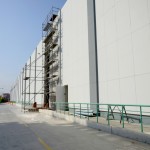Throughout human history, our ability to navigate and orient ourselves has been deeply intertwined with the natural environment. From the earliest days before modern compasses and GPS, natural signs and fire played crucial roles in guiding explorers, travelers, and indigenous communities. Understanding these age-old methods not only sheds light on our ancestors’ ingenuity but also offers valuable insights into sustainable and intuitive navigation today.
Table of Contents
2. The evolution of using fire as a guiding tool
3. Fundamental concepts of fire and nature as navigational aids
4. The psychological and cultural significance of fire in navigation
5. Practical techniques and examples of using fire and nature to find your way
6. The science behind embers, sparks, and wood construction in navigational contexts
7. Non-obvious aspects of fire and nature in navigation
8. Case studies and historical examples of navigating using fire and nature
9. Challenges and limitations of relying on fire and nature for navigation
10. Conclusion: Integrating ancient wisdom and modern innovation
1. Historical reliance on natural signs for orientation
Before the advent of modern technology, humans depended heavily on natural indicators to determine direction. Observing the position of the sun and stars, animal migration patterns, and natural landmarks allowed early explorers to navigate vast terrains with remarkable accuracy. For example, Polynesian navigators skillfully used star constellations and ocean swells to travel thousands of miles across the Pacific, relying solely on natural cues.
2. The evolution of using fire as a guiding tool
Fire’s role in navigation evolved from simple survival to a sophisticated signaling method. Early humans learned to create and control fire not just for warmth and cooking but also for creating visible signals — especially at night or across distances. Fires could mark a campsite, serve as a beacon for others, or indicate safe passage through dangerous territories. Over time, the strategic placement and use of fire became an integral part of survival and migration strategies.
3. Fundamental Concepts of Fire and Nature as Navigational Aids
a. How natural phenomena inform human direction finding
Natural phenomena such as the sun’s position, star patterns, wind directions, and animal behaviors provide reliable clues. For instance, in the Northern Hemisphere, the North Star (Polaris) historically served as a fixed point to find north during night navigation. Similarly, observing the flight patterns of birds or the flowering of certain plants can hint at seasonal changes or specific directions.
b. The role of fire in survival and signaling in the wild
Fire acts as a signal that is visible over great distances, especially in darkness or fog. It can be used to mark a location, summon aid, or guide others. For example, stranded travelers or explorers have historically created signal fires on hilltops or open plains to attract rescuers, demonstrating fire’s vital role in survival scenarios.
c. The scientific principles behind fire’s enduring glow and sparks
Fire’s ability to glow and produce sparks is rooted in combustion chemistry. The oxidation of fuel releases energy, producing heat, light, and sparks. Embers, composed of partially burned material, emit infrared radiation and a steady glow, making them durable sources for warmth and signaling. Sparks, generated by friction or striking certain minerals, can ignite dry materials at a distance, a principle exploited in traditional fire-starting methods and modern signaling devices.
4. The Psychological and Cultural Significance of Fire in Navigation
a. Fire as a beacon of safety and guidance across cultures
Across civilizations, fire has symbolized safety, hope, and guidance. Indigenous tribes have used fire signals to communicate across distances, while medieval lighthouse beacons illuminated treacherous coastlines for mariners. The psychological comfort of a fire also provides reassurance in unknown environments, reinforcing its importance in human survival and culture.
b. Symbolism of fire and natural signs in myth and tradition
Mythologies often depict fire as divine or mystical, representing enlightenment, knowledge, and guidance. For example, Prometheus’s gift of fire to humanity symbolizes enlightenment and progress. In many traditions, natural signs such as the flight of birds or the appearance of certain stars are considered messages from the divine, reinforcing the deep cultural connection between nature, fire, and navigation.
5. Practical Techniques and Examples of Using Fire and Nature to Find Your Way
a. Recognizing natural indicators like stars, sun, and animal behavior
Skilled navigators use the sun’s position at midday to determine east and west, while stars like Polaris provide a fixed point at night. Animal behaviors, such as the flight of certain migratory species or dawn chorus, can also indicate time and direction. For example, the orientation of moss on trees, often thought to grow more on the north side in the Northern Hemisphere, has historically been used as a natural compass.
b. Utilizing fires and sparks for signaling and orientation in survival scenarios
In survival situations, constructing a fire on a high point or open area maximizes visibility. Creating smoke signals or a continuous fire ensures visibility over long distances. Sparks, generated by striking flint and steel or friction-based methods, can ignite tinder or dry materials to start fires quickly, which is vital for warmth and signaling.
c. Modern adaptations: How tools like bruv !! exemplify innovative use of fire in navigation
Contemporary innovations integrate traditional fire-making principles with modern technology. Devices like PyroFox demonstrate how controlled fire tools can enhance signaling capabilities, especially in remote or emergency situations. Such tools embody the enduring human reliance on fire as a navigational aid, adapted to meet the needs of today’s explorers and survivalists.
6. The Science Behind Embers, Sparks, and Wood Construction in Navigational Contexts
a. Why glowing embers can be reliable for prolonged signaling or warmth
Embers retain heat long after the flame has died down, making them excellent for maintaining a steady source of warmth or a long-lasting signal. Their infrared emission can be detected over considerable distances, especially in conjunction with reflective surfaces or in cold environments.
b. How sparks can be deliberately generated to ignite distant or dry materials
Generating sparks through striking flint against steel, or friction methods like bow drills, allows for quick ignition of tinder. This principle is fundamental in traditional fire-starting techniques and can be employed to ignite signals or create fires at a distance, critical for survival and navigation.
c. The importance of construction elements like metal rivets in maintaining fire-related tools and structures
Durable tools used for fire-starting or maintaining signal fires often incorporate metal components such as rivets or fittings. These elements ensure structural integrity, enabling repeated use in rough conditions. Proper construction enhances reliability, especially in life-or-death navigation scenarios.
7. Non-Obvious Aspects of Fire and Nature in Navigation
a. Subtle natural clues: animal migration patterns, plant growth, and weather changes
Beyond obvious signs, subtle environmental cues can inform navigation. For example, the timing of bird migrations or flowering plants can indicate the change of seasons or directionality based on environmental cues. Weather patterns, such as wind shifts, can also affect the success of fire signals or the safety of travel.
b. The influence of environmental conditions on fire-based signaling effectiveness
Humidity, wind, and rainfall significantly impact fire visibility and control. High humidity can suppress flames, while wind can spread or extinguish fires unpredictably. Understanding these conditions helps in planning effective fire signals or choosing safe, reliable methods of navigation.
c. The role of technology in enhancing traditional fire and nature cues for modern navigation
Modern devices, including GPS and environmental sensors, augment traditional methods, allowing users to interpret natural signs with greater accuracy. For instance, apps can analyze star positions or weather data to assist in navigation, bridging ancient wisdom with contemporary technology.
8. Case Studies and Historical Examples of Navigating Using Fire and Nature
a. Indigenous methods of orientation using natural landmarks and fire signals
Many indigenous groups, such as the Aboriginal Australians, used a combination of natural landmarks and fire signals to navigate vast deserts and forests. They relied on knowledge of star paths and fire beacons to communicate across long distances, maintaining safety and cultural continuity.
b. Famous survival stories where fire and environmental cues led to rescue or safety
One notable example is the story of the 1972 Andes plane crash survivors, who used fire signals and environmental knowledge to attract rescuers. Their ability to interpret weather patterns, smoke signals, and natural surroundings was crucial to their eventual rescue.
c. Contemporary innovations inspired by traditional wisdom—highlighting PyroFox as an example
Modern tools like PyroFox demonstrate how ancient principles of fire creation and signaling are being integrated into new technologies. These innovations serve as powerful reminders that understanding and harnessing natural cues remain vital, even in the digital age.
9. Challenges and Limitations of Relying on Fire and Nature for Navigation
a. Environmental constraints and unpredictability of natural signs
Unpredictable weather, terrain, and environmental changes can diminish the reliability of natural signs and fire signals. For example, fog or rain can obscure stars or extinguish fires, complicating navigation efforts.
b. Risks associated with fire in different terrains and conditions
Fire can pose significant risks, including wildfires, burns, or unintentional spread. In dry or windy conditions, a small spark can lead to devastating fires, making fire-based navigation potentially dangerous without proper expertise.
c. Strategies to mitigate limitations using modern tools and knowledge
Combining traditional knowledge with modern safety equipment, such as fire-resistant shelters, GPS, and weather forecasts, can mitigate these risks. Training in fire safety and environmental awareness remains essential for those relying on natural cues.
10. Conclusion: Integrating Ancient Wisdom and Modern Innovation to Find Our Way
The enduring relevance of fire and natural signs in navigation underscores humanity’s deep connection to the environment. While technological advances have transformed how we navigate, the fundamental principles—reading the stars, observing natural cues, and harnessing fire—continue to inform and inspire. Modern innovations, like bruv !!, exemplify this integration, bridging traditional skills with cutting-edge tools.
«Understanding and respecting nature’s signs is key to safe and effective navigation—both in the wild and in everyday life.»
By cultivating mindful observation of our environment and appreciating the science behind natural signals, we can strengthen our innate navigational skills and foster a deeper bond with the natural world.

 Centro Empresarial El Nuevo TRIGAL
Centro Empresarial El Nuevo TRIGAL  proyectos@mmgsa.com
proyectos@mmgsa.com  (+51) 01 273-0641
(+51) 01 273-0641 






